Eventing star, David Middleton is legendary for finding his horses in all sorts of obscure places and usually for a couple of hundred dollars. So it was a big change in operating styles, to see Dave at the Auction of the Stars, trying out purpose bred Warmbloods in his search for his next frontliner. He bought one – paying the top price at the auction for Mr Shirvington, a colt, by the imported Dutch stallion, Salute out of a Thoroughbred mare by Grosvenor out of a Sovereign Edition mare, bred by Heath and Rozzie Ryan.
Thanks to some really lucky breaks in the otherwise dark and threatening Gippsland sky above the Middleton’s Warragul Equestrian Centre, we were able to capture some stunning shots of Dave and the new guy in action, and after that was all done, with the rain starting to patter down, find out what is was like to jump on the Dumb-blood Bandwagon…
Was it a shock to the system, buying a horse that was bred for equestrian sport, rather than chasing behind the man with the PAL cart?
“It’s getting hard to find good ones, and Thoroughbreds are getting scarcer. I heard about the Auction of the Stars, and Shirvington was the one I wanted. He had class. He felt a lot more balanced, and seemed a lot more obliging. He also had great technique over a jump. There was another one with an exceptional jump, but it was a bit feral before the jumps, and I’ve had enough feral horses in my life.”
He’d been broken in?
“He’d been broken in at Heath Ryan’s NSW Equestrian Centre and I think he’d been taken to some little combined training days by the students. When I rode him, he went in a lovely frame and was really up in front but when I got him home, I found he didn’t go forward at the time he should or slow down when I wanted. He was only a baby – so I’ve been working on the going and coming back.”
“I think he had only been jumping two feet six before he came down to the auction, and I said to Heath, come on, what can you show me, when he got to four foot three, he said I think that might be enough. But he was jumping really well.”
Since you’ve had him have you been concentrating on the flat work or the jumping?
“I’ve been working more on the flat because he has only just turned four, so I don’t want to over jump him. Over the next 12 months I’ll start to increase the jumping, but the better he gets in his canter, the better he will jump anyway. He found it hard to stay on his hocks and stay balanced, at the start. I’ve done a lot of work on the canter trying to get him up in front.”
“I’ve been doing quite a lot of canter shorten, lengthen, shorten. The thing I found with him, is that as you came into the jump and needed to shorten, because he didn’t know how to do it, he’d resist a bit. Certainly with the work on the lengthening and shortening, he is getting better at coming into his jumps now. You say whoa, and he comes back better.”
“I do a lot of canter / halt, even with the young ones because I find if you can do good downward transitions, from a canter to a short trot, or a short trot into a short canter, you get a much more balanced canter. I find especially with the ones that tend to want to run in the trot and get a bit unbalanced in the transition, if you do halt / canter / halt, or walk / canter, then when you make your downward transition to trot, they really think of coming back. So many horses run on in their downward transitions, and it is not because they can’t do it – look in the paddock and they all gallop to the gate, halt. It is that they just don’t have the understanding because every time they go into trot, they are used to just falling into it.”
Do you do most of your work in the arena or out over the hills, or a mix?
“I should probably get out a little more. Certainly in the summer it is a bit of a mix, with the worry that the going is hard, so I tend not to do too much cross country, and then in the winter you have to watch that it is not too wet. I like to do a lot of hill work for fitness – I base all my fitness work on hills.”
Are you doing intervals in your hill work?
“I’ve got a little routine where I tend to trot up twice, then canter up twice, with just a really slow shuffly trot down. Most of it is pretty slow work in the canter. I used to do the four runs up to four times, now with the Three Day format changed, I’ll probably cut back a bit. That’s really nice.”
So you are happy to see the end of the traditional three day format?
“Wrapt. We can all do rising trot, we can all gallop flat out at steeple jumps, so I think it was all pretty pointless, and at the end of the day, broke down a lot of good horses.”
Do you have anyone helping you with your dressage?
“Over the years, I’ve had Mary Longden help me – I haven’t seen her so much lately because she has been overseas. I’ve done little bits and pieces with other instructors, leading up to the Worlds and prior to the Trans Tasman, I went to some of the dressage coaches, and they were really good but very expensive! Right now I’m happy to just trundle on, and I think for the lower level stuff, I’ve got a pretty good handle on it. I feel that for a lot of it, I know what I’m after. It is only when I get a good horse, like Willowbank Jack (now renamed Autumn Sky and ridden by Eddie Stibbe – a stable shift that no doubt had something to do with Dave arriving cashed up at the auction), that I need to learn about that higher level. Most of the ones I have at the moment are at a lower level and I pretty much know what to do with them.”
And you put the flying changes on Mr Shirvington to one up Amanda Howell?
“Yeah, I went to a one day event and she was doing half pass with her pre-novice, I thought okay, I’ll teach my guy half pass and flying changes before the next one! Because he is so trainable, I like to get it done now so later it is not a hassle. He has been so easy to train with the changes, and when you are jumping you want to be able to change anyway, so why not teach it now.”
“I had to work on it a little – it was the same as I would do with a Thoroughbred, it just came a whole lot quicker! Teaching changes depends on the horse, generally I start off trying a little bit of half pass into the change. I’m no expert on the flying change, we’ve only been doing them for a few years in eventing… Then you might find that the horse gets a bit used to the half pass to the change so you might use a bit of leg yield instead – it depends on how they are coping. I think it does help with the young ones to get them moving a bit sideways, but like I said, I’m no expert.”
What does your jumping program look like for the babies?
“Obviously you have to keep it well within their capacity. With the young ones you can’t guarantee you are going to get to a great take off spot, like you can with the more advanced horses, so you want the fence height to be low enough that if you make a mistake getting there, they are still confident enough to jump out of it.
If you come into something too big, and you have a bit of a miss, you are going to blow their confidence. I do like to jump bigger fences on them, but I do like to do it in a grid, or in a related line. Especially in the related lines, you can set it up small, and you get the striding nice, then you can build it up because you know you are going to get there on a nice stride.”
How much cross country work do you want to do with a baby?
“I think you want to do lots, provided you are not going to pound their legs. I like to do a heap of cross country, and I quite often train a lot of that in the sand arena, with drums and apexes – even the grid work is really good training for your cross country because it teaches them jump, jump, jump. I like to do something like that with the young ones, twice a week – some sort of cross country paddock work.”
Even today – I guess he has jumped your ditch a few times, but the first time he went over it, he gave it lots of room. Is it important to give them a lot of experience over those sort of jumps?
“Absolutely. You see a lot of riders, they do three events, and they go home, get the dressage and showjumping better, then they come out at novice, do three more events, go home again and come out at Intermediate – in effect when they come out Intermediate, the horse has done six cross country rounds and hasn’t started cross country for three months! You are much better to go event, event, event, if you do go up the levels, well the horse has been doing it for the past five weeks. All I would say is that you don’t want to run them hard every time. If the young ones are good, I don’t like to run them hard, full stop. At the end of the day, winning pre-novice doesn’t interest me that much. There is no reason you shouldn’t be able to canter around all your one day events, and if you do that, they are probably putting in less effort than they do in a good dressage session. Certainly with the young ones the more they see the better. By the time they get to advanced, they’ve probably done 5000 dressage sessions, 1000 jumping sessions, and a lot of horses have only done 10-15 cross country sessions. Cross country is the one you don’t want to make your mistakes at – if you go in and you miss a change, or have a rail down, so what? Somersault on the cross country and it can get ugly.”
You don’t have a training water jump?
“I’ve got a hole in the ground that was going to be for water, but to keep water in it might cost about $5000 worth of concreting so I guess it will stay a hole in the ground. I teach them about water at the smaller events – it would be really nice to school it at home. Generally I find if you train them to jump everything else properly, the water is no different. Providing you haven’t done something stupid, like jump them into a dam, or a deep creek. As the horse comes along, if they haven’t got the experience they look at the water jump, much the same as coming up to a ditch. I tend to get them right back, really shortening the canter, then I can afford to drill them on the last few strides. I do exactly the same with the ditches, get them back a bit, then drill them in the last few strides – send them forward, make sure they really accelerate those last few strides, and because you got really slow at first, they don’t actually go so fast at the ditch, but because they learn to accelerate into the ditch, they are not coming in and backing off.”
“You see a lot of riders with problems with horses stopping at ditches, and I think ditches are just the easiest fence to jump but their problem is that they worry about the ditch, and they get up the horse and get it galloping, but they are galloping nowhere near the fence. If you look at horses that stop at ditches, it is only in the last two strides that they start stopping. If you train them that the last few strides are forward, you never have a problem. But if you come in fast, then you have to slow down to jump the fence. Better to get slow early then move on up to it.”
What’s the biggest problem with Mr Shirvington – waiting for him to get older?
“I guess so. I’m contemplating doing some dressage with him. I’ve only done a couple of dressage competitions when I had Jack. He was pretty good on the flat but he didn’t have a lot of motivation. This guy, I think it could be something else to do. I won’t say I am excited about doing it but I do think I should do a few dressage competitions – and I should do a few showjumping competitions too, because now I’ve got a few horses that jump nicely. I’m just looking forward to see what the future brings with this horse – I certainly think he is something special.”

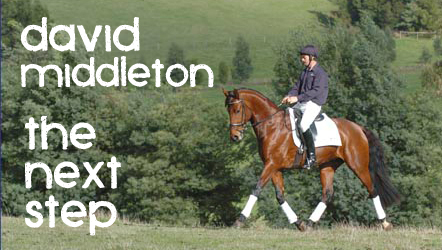
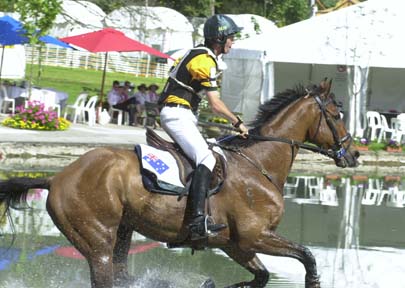
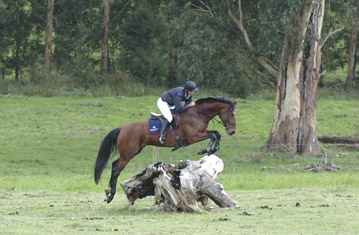
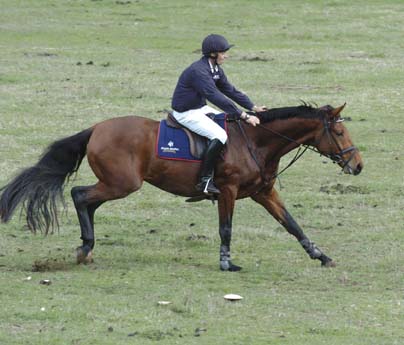
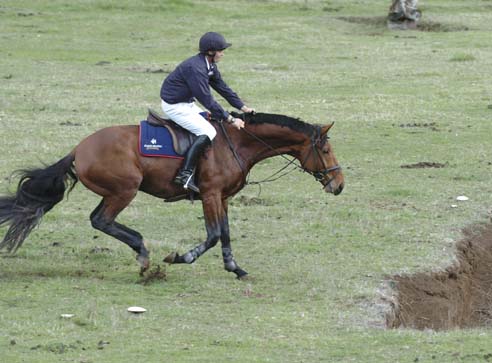
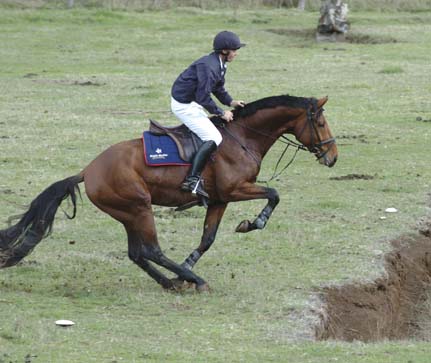
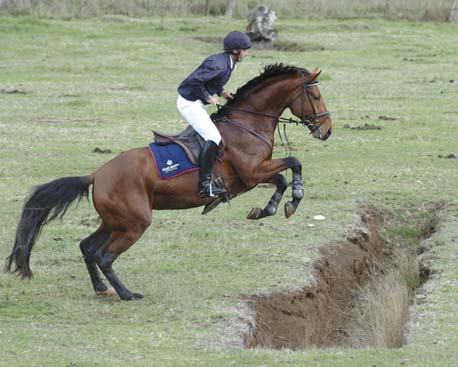
I have lessons with HIM!!!!!!!!!!!!!!!!!!!